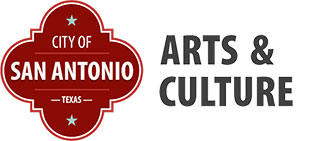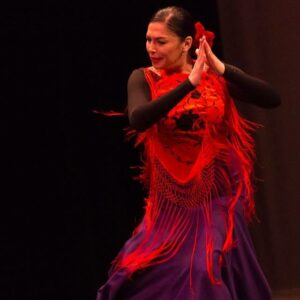Jessica Cerda
Jessica Cerda, a native San Antonian, is a Flamenco Dancer who discovered the art of flamenco as a young professional working as the public relations manager for the local arts organization Guadalupe Cultural Arts Center. Having been a live-long student and performer of dance – ballet as child, jazz and hip-hop throughout junior high and high school, experiencing her first flamenco performance ignited a spark, passion and desire to learn this art form and some day take the stage as a flamenco dancer. She enrolled in beginner lessons at the Guadalupe Dance Academy and then branched out to learn from different local instructors. After performing many ensemble pieces, trios and duets in numerous shows and recitals over the years, she traveled to Spain with fellow flamenco students.
Traveling to Spain to study at the world-renowned flamenco school in Madrid, Amor de Dios and around Sevilla were defining moments in her flamenco education. Experiencing the flamenco culture first-hand and grasping the true meaning of flamenco where it originated gave much more perspective than choreographed dances she had been learning back home. The locals danced bulerias, one of the most complex and fastest rhythms in flamenco, with style and ease and her desire to dance flamenco in such a way left her searching for the maestro or teacher who could help her learn in such a way. It would require learning about one of the most important and original elements of flamenco, the cante or singing.
B ... view more »
Artist Statement of Work
I have been a student of flamenco for more than 25 years and I have learned that while I may never master this artform, I can become a masterful performer of it and infuse a unique style of my own. For me, one of the most fascinating things about flamenco is its diversity and inclusivity from influences around the world. Its origins, the pillars of the art of flamenco being cante/singing, baile/dance and toque/guitar playing will always carry the art form, however, it has drawn from so many other cultures around the world incorporating rhythms in nuevo flamenco with genres including rumba, jazz, blues and even hip hop. Additionally, the incorporation of instruments and props such as castanets, fans, and shawls demonstrate the use and appreciation of many other cultures. When I began my solo performances and choreographies, I began incorporating mudras which are symbolic hand gestures originating from the Buddhist and Hindu religions used in Indian dance. I began studying mudras as they are used to connect the brain and body, stimulate endorphins, relieve pain, and they are also attributed to increasing vitality. One of my current works in progress is a siguiriyas choreography that incorporates the lotus mudra. Siguiriyas is one of flamenco’s oldest palos centered on inconsolable sorrow, pain, and tragedy. It is considered one of the most expressive, personal and deepest forms of flamenco. The lotus mudra is a symbol of purity that opens the heart chakra. The pose encompasses and symbolizes a flower bud originating in the deep, dark muck of pond water that must yearn, a defining feature of grief, to grow towards the light and emerge as a beautiful flower. Just as visual artists and writers use juxtaposition in their works, I seek to juxtapose this symbol of love, light and beauty that emerges from darkness with the deeply expressive siguiriya that highlights our darkest emotions.

